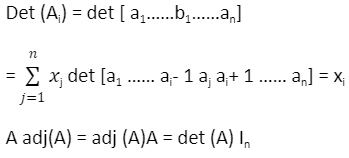In mathematics, a determinant is a scalar value that is a function of a square matrix entry. This allows you to characterize some properties of the matrix and the linear mapping represented by the matrix. In particular, the determinant is non-zero only if the matrix is reversible and the linear map represented by the matrix is isomorphic. The determinant of a matrix product is the product of those determinants (the previous property is the result of this). Each determinant in the 2×2 matrix of this equation is called the submatrix of matrix A. This method can be extended to give a recursive definition of the determinant of an n × n matrix known as the Laplace expansion.
Determinants are often used to represent the coefficients of simultaneous linear equations, and determinants can be used to solve these equations (Cramer’s rule), but other solutions are much more computationally efficient. It will be higher. Determinants are used to define characteristic polynomials for matrices whose roots are eigenvalues. In geometry, the signed n-dimensional volume of an n-dimensional parallelepiped is represented by a determinant. It is used in calculus using external differential forms and Jacobian determinant equations, especially for variable transformations of multiple integrals.
Formulas of determinants
The determinant of a matrix is a variety of described best for rectangular matrices. It is used withinside the evaluation of linear equations and their solution. The determinant method facilitates calculating the determinant of a matrix with the use of the factors of the matrix.
For 2*2 matrix
A = [a b]
[c d]
D2*2 = ad-bc
For 3*3 matrix
A = [a b c]
[d e f]
[g h i]
D3*3 = a(ei-fh) – b(di-fg) + c(dh-eg)
There are several equivalent ways to define the determinant of the square matrix A. That is, the number of rows and columns is the same. Determinants can be defined via Leibniz expressions, which are explicit expressions that contain the sum of the products of specific entries in the matrix. Determinants can also be characterized as unique functions depending on the entries in the matrix that satisfy certain properties. This approach can also be used to compute the determinant by simplifying the matrix in question.
Types of determinants
In general, there are three types of determinants:
First-order determinant: This is used to calculate the determinant of a matrix of degree 1. For example, if [a] = A, then the determinant of A is equal to “a”. .. Determinant: This is used for quadratic matrices.
Determinants of degree 2 can be calculated by first multiplying the diagonal elements in the matrix and then finding the difference between these two products.
Third-order Determinant: This is used for cubic matrices. Determinants of degree 3 can be calculated by first adding the products of the diagonal elements of the matrix and then subtracting the sum of the elements perpendicular to the line segment.
The above method is mainly used to solve the biggest problem with determinants. For simpler problems, the above steps can be used by expanding the determinant along the rows of a matrix consisting of a maximum of zeros.
Examples
Find the determinant of [2 3]
[4 8]
a=2 b=3
c=4 d=8
D2*2 = ad-bc
D2*2 = 2(8) – 3(4)
= 16-12
= 4
Find the determinant of [6 1 1]
[4 -2 5]
[2 8 7]
a=6 b=1 c=1
d=4 e= -2 f=5
g=2 h=8 i=7
D3*3 = a(ei-fh) – b(di-fg) + c(dh-eg)
D3*3 = 6(-2*7 – 5*8) – 1(4*8 – (-2*2))
= 6(-54) – 1(18) + 1(36)
= -306
Cramer’s rule
The determinant can be used to describe the solution of simultaneous linear equations described in matrix form as Ax = b. This equation has a unique solution only if x is non-zero. In this case, the solution follows Cramer’s rule.
xi = det (Ai)/ det (A) [i= 1,2,3,….,n]
Where Ai is a matrix formed by replacing the column of A with the column vector b. This is followed by column expansion of the determinant.

Cramer’s rule can be implemented in time. This is comparable to more common methods for solving systems of linear equations, such as LU, QR, and singular value decomposition.
Conclusion
Determinants are primarily used as a theoretical tool. They are rarely explicitly calculated in numerical linear algebra. Determinants have been largely replaced by other application techniques such as reversibility checking and eigenvalue retrieval. However, computer geometry often uses calculations related to determinants.
Historically, the determinant was used long before the matrix. Determinants were originally defined as properties of simultaneous linear equations. The determinant “determines” if the system has a unique solution (executed only if the determinant is non-zero). In this sense, the determinant was first used in the Chinese mathematics textbook The Nine Chapters on Mathematics (a Chinese scholar around the 3rd century BC). In Europe, the solution of a linear system of equations of two Cardano equations was represented in 1545 by an entity like a determinant.
 Profile
Profile Settings
Settings Refer your friends
Refer your friends Sign out
Sign out








